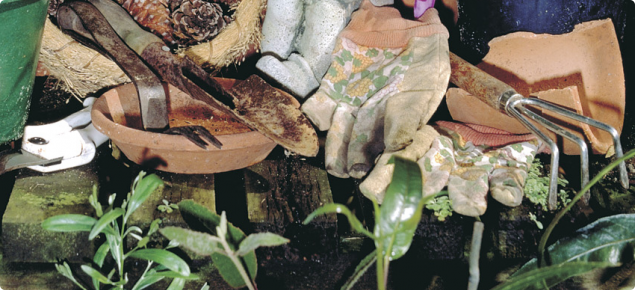Tool quality
It pays to invest in good-quality tools. Pruning saws should be firm and sharp. Spades, forks, hoes, rakes and shovels should be sturdy with solid handles and hardened steel parts, which do not bend easily. Secateurs and other cutting tools should have removable blades and adjustable mechanisms.
Machines, like lawn mowers, whipper snippers, chain saws and hedge trimmers should be easy to clean and sharpen.
Storage
Keeping the tools in a dry shed, preferably on a hanging rack, after they have been washed and sterilised is a major step towards good ‘tool-care’. Smaller tools should be located for easy access on a shelf.
Proper storage will prevent the metal parts from rusting and the wooden handles from disintegrating.
Store chainsaws and hedge trimmers with their cover in place, to prevent injuries.
Tool maintenance
Make sure electrical tools are safe, which means they are properly insulated. If the power cord is damaged have it replaced. It is very important to prevent electrical tools from getting wet.
Keep your wood handled tools in good shape by sanding regularly and applying boiled linseed oil. This will prevent the wood from drying out, cracking and splintering.
Apply lubricant to the movable parts of your tools, to ensure smooth operation and to prevent rust from forming.
If rust has already formed clean with a rust remover.
Simple sharpening tools like files and hand held sharpeners can be used to hone your tools.
Secure your tool and use a file to sharpen the angle, where the tool was previously sharpened. Push the file in one direction until the entire edge is shiny. Protect the sharpened edge against corrosion by applying a small amount of grease.
For smaller tools like pruning shears or loppers, use a small diamond stone for sharpening. The diamond stone can be used like a file. Secure the blade of your tool and file down the previously sharpened edge. Then switch to your fine side and sharpen using the same angle. Your edge is now ready for use.
If you feel the edge starting to get dull again, you can skip the coarse grit and just use a few strokes with the fine stone to keep your tool in good shape.
Keeping tools clean and sterile
Because tools like spades, trowels, hoes, garden forks and wheel barrows are exposed to dirt and moisture, they transmit soil fungi, weeds and nematodes between garden beds. They should be cleaned and preferably sterilised after every job.
Wash the dirt off with your garden hose and if necessary scrub the tools with a brush. Disinfect the tools with a 2% solution of household bleach (sodium hypochlorite) before storage or using them in a different location. Dry your tools thoroughly before putting them away.
Tools, which come into contact with plants, like secateurs and shears, may transmit fungi and viruses. They should be cleaned and sterilised between trees. Use turpentine, to remove stubborn sap, wipe and sterilise the tool. Remember; be careful as you wipe the blades as they are very sharp.
If rust has built up on your tools, remove it with a rust remover.
Disinfectants for garden tools
Alcohol, household cleaners and bleach can be used to sterilise tools. Choose a disinfectant that is readily available, affordable and relatively safe to handle. Some disinfectants, which are used for pruning, are phytotoxic and need to be dried off before use on the next plant. Avoid cutting active, oozing cankers; wait until they dry.

